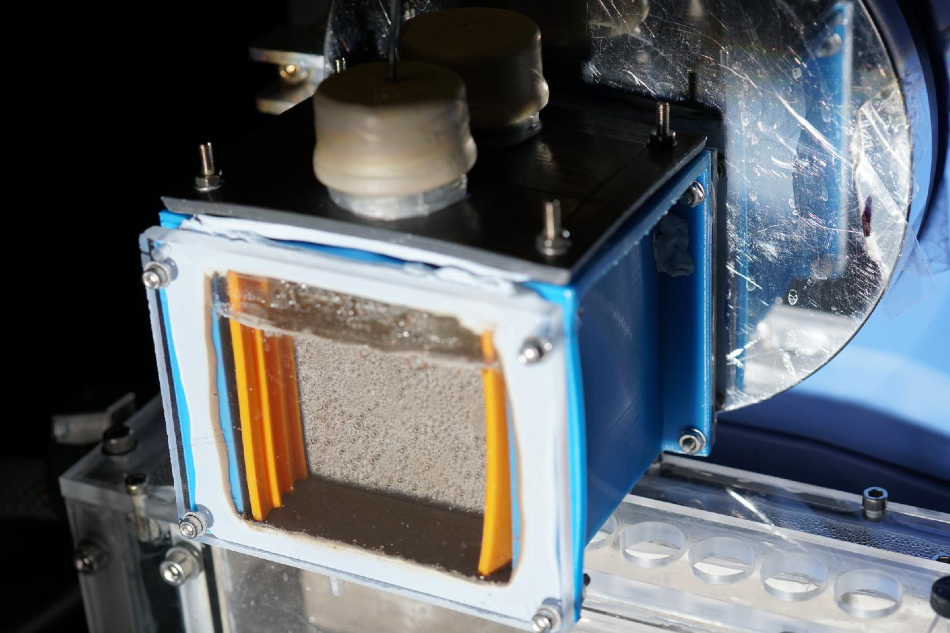Aug 25 2020
A standalone device developed by scientists can convert water, carbon dioxide, and sunlight into a carbon-neutral fuel, without the need for electricity or any additional components.
 This device, developed by a team from the University of Cambridge, is a significant step toward achieving artificial photosynthesis—a process mimicking the ability of plants to convert sunlight into energy. It is based on an advanced “photosheet” technology and converts sunlight, carbon dioxide, and water into oxygen and formic acid—a storable fuel that can either be used directly or be converted into hydrogen. Image Credit: University of Cambridge.
This device, developed by a team from the University of Cambridge, is a significant step toward achieving artificial photosynthesis—a process mimicking the ability of plants to convert sunlight into energy. It is based on an advanced “photosheet” technology and converts sunlight, carbon dioxide, and water into oxygen and formic acid—a storable fuel that can either be used directly or be converted into hydrogen. Image Credit: University of Cambridge.
Created by a research group from the University of Cambridge, the novel device brings scientists one step closer to realizing artificial photosynthesis—a process that imitates the potential of plants to change sunlight into energy.
The device is built on a sophisticated “photosheet” technology and transforms water, carbon dioxide, and sunlight into formic acid and oxygen; the former is a storable fuel that can be either transformed into hydrogen or used directly.
Published in the Nature Energy journal, the study results indicate a novel technique for converting carbon dioxide into clean fuels. The new wireless device could be upgraded and utilized on energy “farms” analogous to solar farms, generating clean fuel by using only water and sunlight.
One of the promising methods to decrease carbon emissions and migrate from fossil fuels is to harvest the Sun’s energy to change carbon dioxide into fuel. However, it is difficult to generate such clean fuels without producing any unnecessary by-products.
It’s been difficult to achieve artificial photosynthesis with a high degree of selectivity, so that you’re converting as much of the sunlight as possible into the fuel you want, rather than be left with a lot of waste.
Dr Qian Wang, Study First Author, Department of Chemistry, University of Cambridge
“In addition, storage of gaseous fuels and separation of by-products can be complicated—we want to get to the point where we can cleanly produce a liquid fuel that can also be easily stored and transported,” stated Erwin Reisner, a Professor and the study’s senior author.
Back in 2019, a solar reactor based on an “artificial leaf” design was developed by scientists from Reisner’s group. This solar reactor also makes use of water, carbon dioxide, and sunlight to generate fuel called syngas.
The appearance and behavior of the novel technology are quite similar to the artificial leaf but it functions in a different way and generates formic acid.
While solar cell components are used by the artificial leaf, the latest device eliminates the need for such components and depends only on photocatalysts integrated into a sheet to generate what is called a photocatalyst sheet. The photocatalyst sheets are composed of semiconductor powders, which can be prepared in huge amounts in a simple and economical way.
Moreover, the novel technology is stronger and generates clean fuel that is simpler to store and demonstrates the ability for generating fuel products at scale. The test unit measures only 20 cm2 in size, but according to the team, it can be easily scaled up to several square meters. The formic acid can also be collected in solution and can be chemically transformed into different kinds of fuel.
We were surprised how well it worked in terms of its selectivity—it produced almost no by-products. Sometimes things don’t work as well as you expected, but this was a rare case where it actually worked better.
Dr Qian Wang, Study First Author, Department of Chemistry, University of Cambridge
The new cobalt-based catalyst to convert carbon dioxide is comparatively stable and can be created easily. Although the new technology will be relatively easy to scale up when compared to the artificial leaf, the efficiencies should still be enhanced before considering any commercial deployment.
The team is trying out an array of different catalysts to enhance both efficiency and stability.
The researchers obtained the present results in association with the group of Kazunari Domen, a Professor and the study’s co-author from the University of Tokyo.
Currently, the team is working to further improve the system and enhance efficiency. To get different types of solar fuels, they are also examining other catalysts for use on the new device.
We hope this technology will pave the way toward sustainable and practical solar fuel production.
Erwin Reisner, Study Senior Author and Professor, University of Cambridge
Journal Reference:
Wang, Q., et al. (2020) Molecularly engineered photocatalyst sheet for scalable solar formate production from carbon dioxide and water. Nature Energy. doi.org/10.1038/s41560-020-0678-6.